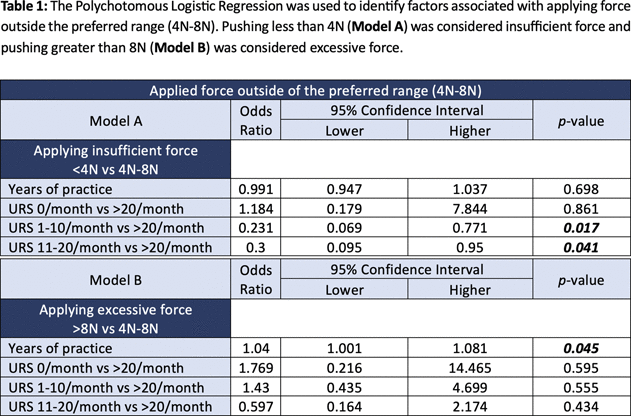Abstract
INTRODUCTION AND OBJECTIVE:
Ureteral access sheath (UAS) placement has been associated with a 13-26% incidence of high-grade ureteral injuries. Our recent laboratory and clinical studies documented that UAS insertion forces up to 8 N are safe, while exceeding 8 N may result in high-grade injuries. Accordingly, we sought to evaluate UAS insertion force among urologists and residents-in-training.
METHODS:
Participants were recruited at the 2022 American Urological Association (AUA) and the World Congress of Endourology and Technology (WCET) meetings. Participants sequentially introduced 12Fr, 14Fr, and 16Fr UAS into a draped male genitourinary model which housed a concealed force sensor. The model was designed to preclude passage of the 16Fr UAS. Those with UAS experience were asked to pass the UAS as they would during a standard ureteroscopy (URS), while those without UAS experience were told to use what they deemed to be reasonable force. Participants were blinded to force recordings. Demographics were collected via an online survey. Predictive factors for insufficient force (<4 N), preferred force (4-8 N), or excessive force (>8 N) during 16Fr UAS placement were analyzed using a polychotomous logistic regression model.
RESULTS:
Among 121 participants (74 AUA, 47 WCET), 88% were male and 12% were female. These included 27 residents/fellows, 94 faculty and community urologists. Monthly URS experience varied: 7% (0 URS), 37% (1-10 URS), 30% (11-20 URS), and 26% (>20 URS). UAS placement was routine for 73% of participants. Among the participants, 29% applied insufficient force (<4 N) while 32% applied excessive force (>8 N). When comparing excessive force (>8 N) relative to preferred force (4-8 N), participants with more years of practice were more likely to apply forces >8 N (OR 1.04, 95% CI 1.001-1.081, p=0.045) (Table 1).
CONCLUSIONS:
During UAS passage, only 39% of urologists applied force in the preferred range of 4-8N. A third of urologists exceeded 8N, risking high-grade ureteral injury. Another third of urologists fell below 4N, potentially compromising the procedure by using a smaller sheath than the ureter would accept.

Source: https://www.auajournals.org/doi/10.1097/01.JU.0001009564.26544.1c.04





